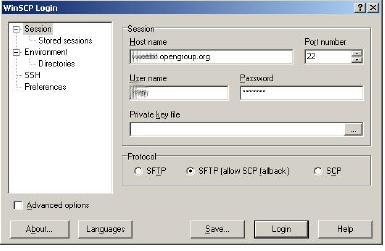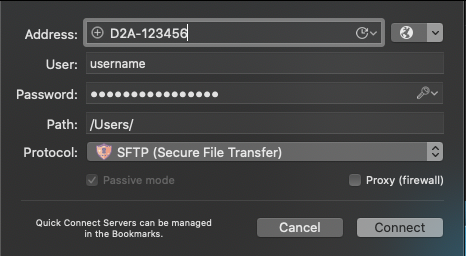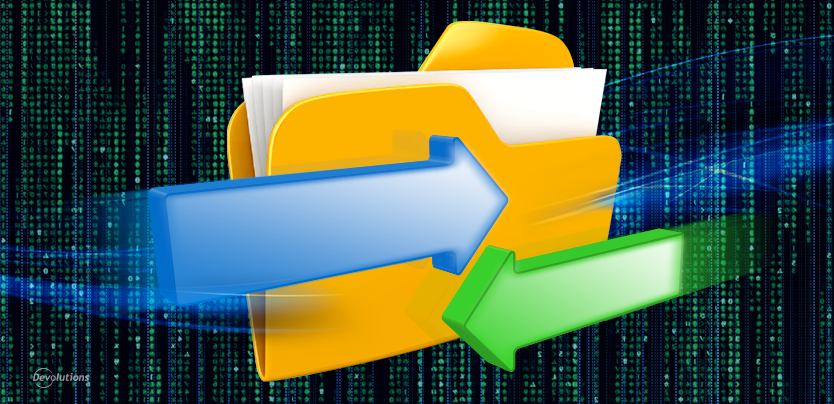
O sshoption Can be used to pass options to ssh in the format used in sshconfig(5). This is useful for specifying options for which there is no separate sftp command-line flag. For example, to specify an alternate port use: sftp -oPort=24. For full details of the options listed below, and their possible values, see sshconfig(5). Apple Mac OS X comes with SSH pre-installed. Go to Applications- Utilities- Terminal.app- At the prompt, type 'ssh username@euclid.ucsd.edu'. Use Software Update or manually download software updates to update to the latest SSH version. For a graphical SFTP client, download and install Cyberduck, Fetch, or FileZilla. Or use the pre-installed command-line 'sftp' or 'scp.
Recently, we looked at the rsync command for syncing files between locations, and we discussed the similarity of usage and syntax when duplicating files and directories with the cp Periodic number 13. command. In that article, we looked at moving the bits back and forth on the same box, between filesystems, or between devices. In an upcoming article, we'll look more at rsync as a tool to keep remote filesystems in sync with a local or backup version. In this article, I want to take a look at one of the most useful and used tools in the Linux sysadmin toolbox—the scp command.

Ssh-scp-sftp-chroot-jail
Windows Putty Client Disable Root AccessTransfer Files With SFTP or SCP - WinSCP Windows ClientWindows Power Shell ClientLinux Client (Kali Linux)Playlist: h.
Sftp Vs Scp
What is SCP?
Sftp Scp Server
Linux Security
Secure Copy, or scp, is a secure version of the older rcp tool (which is still used, but less common) included in the OpenSSH suite of tools.
OpenSSH started as a BSD fork of the original SSH secure communications protocol, which has since become re-licensed as 'non-free' and thus not generally available for Linux. OpenSSH is still maintained under the BSD license and is available for a wide range of platforms. Whatsapp web chrome os. It includes several common tools for secure remote access, including key generation, scp, and sftp (a secure version of FTP, which we'll get to in a bit).
Recently, OpenSSH developers have indicated that they consider scp to be deprecated (they believe it is 'Outdated, inflexible and not easily fixed'). It is unclear when it will cease to be available in future releases of OpenSSH, though it's hard to imagine that it will be dropped anytime soon.
Use SCP
The usefulness of scp lies in its simplicity. I use it to quickly move files to a remote filesystem from the shell:
Easy as pie. I can get a file from a remote location, too:
The available connection options are the same as with ssh. For example:
-P specifies the port for the ssh connection, -i specifies an ssh id key to use for authentication: Both these options are useful for scripts. Note that the scp -P differs from the ssh -p for specifying the port. In the example above, I set the location of an ssh key (~/.ssh/id_rsa)—which I also generated using the OpenSSH toolkit—to authenticate access to the remote device. Learn about SSH file copies here.
So you can see scp is a really useful tool to have at your fingertips. There is some discussion of the wisdom of using this tool in a secure environment, so YMMV. I'd suggest doing some reading and deciding for yourself.
[ You might also like: Sysadmin tools: Using rsync to manage backup, restore, and file synchronization ]
Alternatives
What if, for whatever reason, we can't use scp? I recommend two other options that are pretty easy to use: rsync, which we have talked about here and will discuss in more depth in another article, and sftp. While neither of these options is as convenient as scp, both have some useful features.
sftp is pretty much what it sounds like: Secure FTP. It acts like FTP over an SSH-managed connection. While it's not as simple to use as the 'one and done' scp command, it offers a range of more sophisticated filesystem options and the ability to connect to a remote filesystem interactively. It does require that the target filesystem be configured for sftp access.
Let's connect to an sftp server interactively:
If we hit Tab twice, we can see a list of commands available at the shell:
So you can see it's possible to interact with the remote filesystem. Again, the main disadvantages are the target has to be configured for sftp access and access to a specific directory has to be configured and limited by the admin of that system. This makes it a more secure, if less convenient, option than scp. Also, note that while it's not really possible to do impromptu file transfers like scp, it is possible to write scripts and insert shell aliases to make this work more smoothly if that's your jam.


O sshoption Can be used to pass options to ssh in the format used in sshconfig(5). This is useful for specifying options for which there is no separate sftp command-line flag. For example, to specify an alternate port use: sftp -oPort=24. For full details of the options listed below, and their possible values, see sshconfig(5). Apple Mac OS X comes with SSH pre-installed. Go to Applications- Utilities- Terminal.app- At the prompt, type 'ssh username@euclid.ucsd.edu'. Use Software Update or manually download software updates to update to the latest SSH version. For a graphical SFTP client, download and install Cyberduck, Fetch, or FileZilla. Or use the pre-installed command-line 'sftp' or 'scp.
Recently, we looked at the rsync command for syncing files between locations, and we discussed the similarity of usage and syntax when duplicating files and directories with the cp Periodic number 13. command. In that article, we looked at moving the bits back and forth on the same box, between filesystems, or between devices. In an upcoming article, we'll look more at rsync as a tool to keep remote filesystems in sync with a local or backup version. In this article, I want to take a look at one of the most useful and used tools in the Linux sysadmin toolbox—the scp command.
Ssh-scp-sftp-chroot-jail
Windows Putty Client Disable Root AccessTransfer Files With SFTP or SCP - WinSCP Windows ClientWindows Power Shell ClientLinux Client (Kali Linux)Playlist: h.
Sftp Vs Scp
What is SCP?
Sftp Scp Server
Linux Security
Secure Copy, or scp, is a secure version of the older rcp tool (which is still used, but less common) included in the OpenSSH suite of tools.
OpenSSH started as a BSD fork of the original SSH secure communications protocol, which has since become re-licensed as 'non-free' and thus not generally available for Linux. OpenSSH is still maintained under the BSD license and is available for a wide range of platforms. Whatsapp web chrome os. It includes several common tools for secure remote access, including key generation, scp, and sftp (a secure version of FTP, which we'll get to in a bit).
Recently, OpenSSH developers have indicated that they consider scp to be deprecated (they believe it is 'Outdated, inflexible and not easily fixed'). It is unclear when it will cease to be available in future releases of OpenSSH, though it's hard to imagine that it will be dropped anytime soon.
Use SCP
The usefulness of scp lies in its simplicity. I use it to quickly move files to a remote filesystem from the shell:
Easy as pie. I can get a file from a remote location, too:
The available connection options are the same as with ssh. For example:
-P specifies the port for the ssh connection, -i specifies an ssh id key to use for authentication: Both these options are useful for scripts. Note that the scp -P differs from the ssh -p for specifying the port. In the example above, I set the location of an ssh key (~/.ssh/id_rsa)—which I also generated using the OpenSSH toolkit—to authenticate access to the remote device. Learn about SSH file copies here.
So you can see scp is a really useful tool to have at your fingertips. There is some discussion of the wisdom of using this tool in a secure environment, so YMMV. I'd suggest doing some reading and deciding for yourself.
[ You might also like: Sysadmin tools: Using rsync to manage backup, restore, and file synchronization ]
Alternatives
What if, for whatever reason, we can't use scp? I recommend two other options that are pretty easy to use: rsync, which we have talked about here and will discuss in more depth in another article, and sftp. While neither of these options is as convenient as scp, both have some useful features.
sftp is pretty much what it sounds like: Secure FTP. It acts like FTP over an SSH-managed connection. While it's not as simple to use as the 'one and done' scp command, it offers a range of more sophisticated filesystem options and the ability to connect to a remote filesystem interactively. It does require that the target filesystem be configured for sftp access.
Let's connect to an sftp server interactively:
If we hit Tab twice, we can see a list of commands available at the shell:
So you can see it's possible to interact with the remote filesystem. Again, the main disadvantages are the target has to be configured for sftp access and access to a specific directory has to be configured and limited by the admin of that system. This makes it a more secure, if less convenient, option than scp. Also, note that while it's not really possible to do impromptu file transfers like scp, it is possible to write scripts and insert shell aliases to make this work more smoothly if that's your jam.
[ Thinking about security? Check out this free guide to boosting hybrid cloud security and protecting your business. ]
Wrap up
Final note: Both these tools rely on the SSH toolbox, which is a very important part of Linux systems administration, so I highly recommend getting comfortable with it. Consider these excellent articles by Enable Sysadmin writers:

